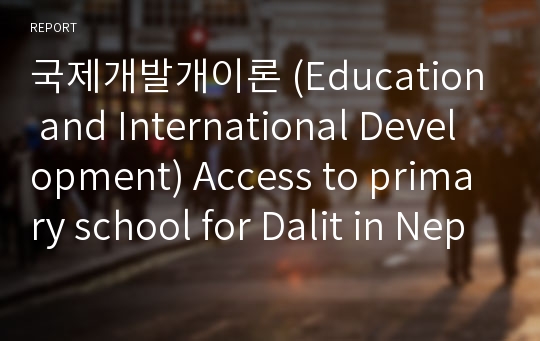국제개발개이론 (Education and International Development) Access to primary school for Dalit in Nepal
개발협력
다운로드
장바구니
소개글
영국 석사 대학원 국제개발 전공 리포트 입니다.네팔의 카스트 제도 아래에서 어떻게 불가촉 천민(달릿)의 아이들이 기본교육인 초등교육에 접근 할 수 있는가에 대해 인적자본이론과 인권의 관점에서 쓴 리포트 입니다.
이 리포트는 영어로 작성되었습니다.
목차
1. Introduction2. The history of the Caste system in Nepal
3. Importance of Primary Education
4. The Dalit’s situation in Nepal: Low literacy rates and school enrollment
5. Rights based approach - Right to education
6. Analysis of the issues in the Rights-Based Approach perspective: Caste hindrance for access to school
1) Caste discrimination in schools
7. The 4a frame work
1) Availability
2) Accessibility
3) Acceptability
4) Adaptability
8. Human capital theory
9. Human Capital Theory and access to primary education for the Dalit children in Nepal
10. Human rights based approach and human capital theory compared
11. Conclusion
12. References
본문내용
IntroductionNepal has a caste system despite its legal prohibition since 1963. As a result discriminations between the different castes are prevalent. However, the caste system was made illegal, but despite this breach of law, caste discrimination still persists. Nepal is a land-locked country which is located between India and China. The Nepalese population maintains the tradition of Hinduism. (Thapaliya, 2007).
Most Dalit’s who are outside of the caste system socially and politically, are discriminated against by their social and caste status. This is particularly, in the Nepalese education sector whereby discrimination is a wide spread problem. This is because most teachers belong to the higher caste level. This is turn means that they do not want the Dalit’s in the classrooms with them, despite there being no schools in the Dalit community. As a consequence, the Dalit’s are relatively excluded from education by other caste groups (Chunu, 2010) and Dalit children struggle to acce
참고 자료
Acharya, S. (2007). Social Inclusion : Gender and Equity in Education SWAPs in South Asia (Nepal case study) (pp. 184). UNICEFBartlett, S. (2004). 'Everyone counts: dalit children and the right to education in Nepal'. [Online], 52. Available at: http://cergnyc.org/files/2011/09/Dalit-mar-41.pdf.
Bharati, S. (2010). 'Primary education and economic development in Nepalese rural village: focusing on talku dudechar village'.
[Online], Available at: http://www.arsa1996.org/pictures/pdf/ARSA_IV_PRCDGS_VOL1/SOCIOCULTURAL%20AND%20POLICY%20ISSUES%20IN%20RURAL%20DEVELOPMENT/4_BHARATI_178-189.pdf.
Bhattachan, K. B., Sunar, T. B. and Gauchan, Y. K. (2009). 'Caste-based Discrimination in Nepal '. 3 (8), 59. [Online], Available at:
http://idsn.org/fileadmin/user_folder/pdf/New_files/Nepal/Caste-based_Discrimination_in_Nepal.pdf.
Bishwakarma, M. B. (2011). 'A comparative study of Dalit Education in Nepal'. [Online], 16. Available at: http://ssrn.com/abstract=18221630.
Chunu, P. (2010). 'Dalit and Exclusive Policies: A Case of Scheduled Castes in Arunachal Pradesh'. 24.
Deshpande, M. S. (2010). 'History of the Indian caste system and its impact on India today'.
[Online], 22. Available at: http://digitalcommons.calpoly.edu/cgi/viewcontent.cgi?article=1043&context=socssp.
Devkota, S. P. (2011). ' Necessity of Inclusive Education to Address the Dalit Communities'.
[Online]. Academia.edu, 15. Available at: https://www.academia.edu/3626665/Necessity_of_Inclusive_Education_to_Address_the_Dalit_Communities.
Diokno, M. S. I. (2002). 'Workshop on the Implementation of Rights-based Approach to Development: Training Manual'. [Online]. Available at: http://ph.one.un.org/publications/RBAManual.pdf.
Gajurel, K. P. (2006). Unequal Citizens: Gender,Caste and Ethnic Exclusion in Nepal (Summary) (pp. 72). Nepal: The World Bank and DFID
Gautam, K. C. (2008). 'Quality Basic Education as the Foundation for Nepal's Development '. [Online]. Available at: http://www.rbf.org.np/speech_kul_c_gautam.pdf.
Government of Nepal (2013). Nepal Millennium Development Goals progress report 2013. Nepal
Hatlebakk, M. (2009). 'Capacity-constrained Collusive Price Discrimination in the Informal Rural Credit Markets of Nepal'. [Online], 13 (1), 70-86. Available at: http://onlinelibrary.wiley.com/doi/10.1111/j.1467-9361.2008.00461.x/abstract.
Husager, G. D. (2013). ' Caste discrimination and human rights'. [Online]. Available at: http://www.idsn.org/fileadmin/user_folder/pdf/New_files/UN/UNcompilation.pdf.
ILO. (2005). Dalits and Labour in Nepal: Discrimination and Forced Labour (5 ed.). Nepal: International Labour Organization (ILO).
Iversen, T. O. (2013). 'Poverty dynamics among the Dalits of Tarai '.
[Online]. Available at: http://www.cmi.no/publications/file/4966-poverty-dynamics-among-the-dalits-of-tarai.pdf.
Olaniyan, D. A. and Okemakinde, T. (2008). 'Human Capital Theory: Implications for Educational Development'.
[Online], 5 (5), 479-483. Available at: http://medwelljournals.com/abstract/?doi=pjssci.2008.479.483.
Psacharopoulos, G. and Patrinos, H. A. (2004). 'Returns to Investment in Education: A Further Update '.
[Online], 12 (2), 24. Available at: http://siteresources.worldbank.org/INTDEBTDEPT/Resources/468980-1170954447788/3430000-1273248341332/20100426_16.pdf.
Ramchandran, V., Jandhyala, K. and Saihjee, A. (2003). 'Through the Life Cycle of Children: Factors that Facilitate/Impede Successful Primary School Completion'. Economic and Political Weekly, 38 (47), 9.
Rao, J. (2010). 'The Caste System: Effects on Poverty in India, Nepal and Sri Lanka'. [Online], 1 (2), 10. Available at: http://www.american.edu/cas/economics/ejournal/upload/global_majority_e_journal_1-2_rao.pdf.
Ravens, J. v. (2009). 'Early Childhood Development in Nepal: Expansion, Inclusion, Quality'. [Online]. Available at: http://www.globalchilddevelopment.com/sites/default/files/NEPAL%20UNICEF%20ECD%20FINANCE.pdf.
Robeyns, I. (2006). 'Three models of education: Rights, capabilities and human capital theory and research in education '. [Online] (4), 17. Available at: http://tre.sagepub.com/content/4/1/69.full.pdf+html.
Shiva, L., Singh, R. B. and Jeevan, L. (2010). 'Universal primary education in Nepal: Fulfilling the right to education'. [Online], 40 (3), 355-374. Available at: http://link.springer.com/article/10.1007%2Fs11125-010-9162-6#page-1.
Shiwakoti, D. R. (2004). 'Free and Compulsory Primary Education in the Context of Education for All'. [Online], 40. Available at: http://www.google.co.uk/url?sa=t&rct=j&q=&esrc=s&frm=1&source=web&cd=1&ved=0CCoQFjAA&url=http%3A%2F%2Fwww.cerid.org%2F%3Fs%3Dformative%26a%3Ddownload%26id%3Dd555dcf102eb6a1cacae33a053d42990&ei=Ac3vUuDGG-GP0AWLjYGIDA&usg=AFQjCNHFgpI9hhqr_g2FJq6YtS0FIUN6yw&sig2=GXh-PQZZwc1zzhUEXJMEDw&bvm=bv.60444564,d.d2k.
Shrestha, A. (2002). 'Dalits in Nepal: Story of Discrimination'.
[Online], 30. Available at: http://www.hurights. or.jp/asia-pacific/no-30/04.htm.
Smith, B. K. (1994). Classifying the Universe: the Ancient Indian Varna System and the Origins of Caste. New York Oxford University Press
Thapaliya, K. D. (2007). Voices of Rural Women in Nepal: Impact of Literacy on the Lives of Women
The World Bank. (2006). Poverty in Nepal.
[Online]. Available at: http://go.worldbank.org/YYS66H6UK0
Tomasevski, K. (2001). 'Human rights obligations: making education available, accessible, acceptable and adaptable'. Right to Education primes, (3), 47.
Tripathy, S. N. (2012). Right to Education: Education for the Deprived Children. New Delhi, India: ABHIJEET.
Tuladhar, G. (2011). 'Status of Education in Nepal and Development Plan'.
[Online]. Available at: http://web.isc.ehimeu.ac.jp/ice/61@Gangalal%20Tuladhar_text%20_8p.pdf.
UNESCO. (2012.) EFA Global monitoring report,
[Online], Available at: http://www.unesco.org/new/en/education/themes/leading- the-international-agenda/efareport/
UNICEF. (2006). 'Situation of Children and Women in Nepal'.
[Online], 240. Available at: http://www.unicef.org/sitan/files/Nepal_SitAn_2006.pdf.
UNICEF. (2007). A human rights-based approach to education for all: UNICEF.
Unterhalter, E. (2009). Social Justice, Development Theory and the Question of Education (Vol. 22, pp. 781-800): Springer Netherlands.
Wagle, D. (2012). 'Droupout of Children from schools in Nepal'. [Online], 119
Watch, H. R. (2007). 'Hidden Apartheid: caste discrimination against India’s “untouchables”'.
[Online], 19 (3 (C)), 118. Available at: http://www.hrw.org/sites/default/files/reports/india0207webwcover_0.pdf.





























